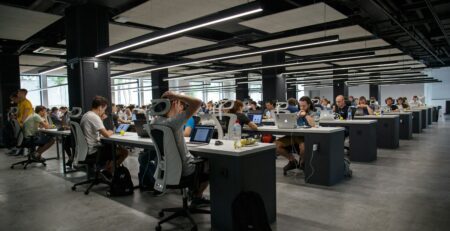How Flexibility Increases Productivity In the Workplace
Work flexibility is a concept that is rapidly taking root in the business industry. It challenges the idea of a traditional 9-5 profession and the need for constant rigidity in the workplace, elevating the average employee experience.
Today, workplace flexibility is evident in flexible work schedules and processes and has been proven to offer numerous benefits. One of these many benefits is increased productivity.
But how exactly does work flexibility increase employee productivity? In this guide, we will examine the concept of flexibility at work, what it is, and how it can help employees be more productive.
What Is Workplace Flexibility?
In the past, working was a monotonous task with a routine that barely changed. All employees were required to have certain schedules, recruit to work on certain days, turn in before certain times, and stick to a schedule many people consider limiting and tiring. However, things have changed so much that employers and employees are striking a better balance using a schedule that best suits them. This is known as workplace productivity.
Workplace productivity is when employers and employees reach arrangements about adopting working conditions that suit them. It is used to maintain a good work/life balance to help employees be more productive at work.
Workplace flexibility focuses on providing great conditions for employees to do their work, perform their duties, and thrive as they do so. This includes introducing benefits such as unlimited time off, flexible work hours, and remote working so employees are not cooped up at work all day.
In the past, workplace flexibility was a concept that would bewilder any employee. In the past, every employment required a present employee who can be found working at their workstation. However, workplace flexibility can now be found in various organizations globally.

The Rise Of Flexible Working
Workplace flexibility might be a modern solution in the business world, but it has been around longer than anyone suspects. Its progress, and perhaps even its origin, can be attributed to a German management consultant named Christel Kammerer.
In 1965, Christel Kammerer argued that balancing childcare and professional duties was a leading cause of the lack of women workers in the job market. As a solution, he proposed the idea of Flextime or flexiwork, a solution that was designed to allow employees to choose their start and end times at work. This idea was widely embraced and enabled employees to tailor their jobs to suit their personal life and enabled them to strike a balance, a benefit that traditional working environments did not offer.
Another notable marker in the history of flexible working was in 1972 when Jack Nilles first coined the term ‘telecommuting.’ At the time, Jack Nilles was an engineer working remotely on a complex NASA communications system which explained why and how the phrase was born.
As the years progressed and technology advanced, flexible working became more of a reality and less of a possibility. With the investigation of software and applications that made it easier to work outside the constraints of a traditional work environment, more and more businesses began to embrace the possibility of a less rigid work culture.
Although the idea of flexible working was created years ago, it didn’t become a prevalent concept until the pandemic hit in 2020.
2020 was the year the coronavirus disrupted normal operations in the business world. It was also the year when flexible working gained more attention in the business world. Following the covid-19 pandemic and the shutdown of major industries due to restrictions, the impossible became possible as managers thought it better to introduce remote-working and hybrid work systems.
With the COVID-19 lockdown posing severe restrictions on the millions of employees globally, flexible working offered a solution that helped workers remain employed by working without having to commute to the office. Although it was a huge shift from normal working conditions that many people were already subjected to, it was quickly adopted as a solution instead of stopping work entirely.
How Has Flexible Working Changed Employment?
The option for flexible working lives on even after the restrictions due to COVID-19 were lifted. It quickly became a staple in many establishments, with many employees adopting a fully remote operation and others adopting a hybrid blend (combination of on-site and remote operation), with these options, employers and employees could tailor work hours and other factors to suit the employee’s comfort and ability.
A Gallup Survey in June 2022 discovered that 8 in 10 employees are working in hybrid or remote settings while only 2 out of 10 are working completely on-site/. Today, many employees and talents use work flexibility to determine if they would like to work with a company or not.
Flexible working has proven to be an innovative solution with many benefits for employers and employees. Flexible working time and working arrangements lay the foundation for a better-work balance. They eradicate- or at least severely lessen- the effect of stress that is usually found in normal working conditions. This ensures the employee is psychologically and physically healthier, helping them perform better at work responsibilities.
Flexible working has been recognized as one of the best ways to save on company costs. It makes this possible by eliminating or drastically reducing direct costs usually associated with traditional workspaces, such as internet use and stationery expenses.
It has also been cited as a great way to build a diverse team as workers of all backgrounds, such as working parents or people with disabilities who may find a traditional workspace stressful, can now work without restrictions. This leads to better recruitment, eliminating the challenges that being stuck in a physical office for 8 hours daily may cause.
However, most importantly, workplace flexibility is one of the biggest contributors to employee productivity.

The Effect Of Workplace Flexibility On Productivity
Flexibility in the workplace means different things to different establishments. However, regardless of what they may mean, the definition of flexibility is never lost. Flexibility at work will always allow employees to choose their working schedules.
Flexible work hours mean employees can tailor their work hours or choose when and how many hours they want to work. This breaks the status quo of the regular 9-5 rule, helping employees be more active than they normally would be. This is supported by Parkinson’s law which states that work shrinks or expands to fit the time available. Hence, less time means more time to be efficient.
One other form of work flexibility is flexible scheduling which means accommodating a worker’s needs when it comes to their work days and days off. This means the worker can deviate from the regular “9-5 for 5 days” work schedule.
Lastly, flexibility exists in terms of flexible workspaces. In this form of workplace flexibility, employees have the freedom to work outside the constraint of the workplace desk. This means the possibilities of remote and hybrid (physical + remote) working.
Whether it is flexible work hours, flexible workspaces, or flexible work schedules, workplace flexibility has been linked to a positive impact on employee productivity.
But what exactly is the explanation for this?
1. Saves Commute
According to a 2019 study, the average American spent 27.6 minutes on a one-way commute to work. This was nearly one hour to and from work. Today, the journey might as well be longer as there are more cars on the streets than there were in 2019. You can find here the 25 cities with the costliest commutes in 2023.
With the average worker spending more than an hour commuting to and fro work, it is easy to see why burnout is widespread in modern society. The stress of getting to work on time already eats deep into the average worker, who is possibly tired before they even start their daily tasks at work.
However, the surge of flexible workspace and schedules has made it so that an employee does not have to commute to work every day. A 9-5 schedule no longer restricts them, and they have the freedom to focus on working when they can where they can.
By implementing work location flexibility, employers can shave time off employee commutes, making it easy for them to focus on work. This will enable employees to be more productive and get more jobs done.
2. Prevents Burnout
By offering time and location flexibility, employers can help their workers prevent burnout. This is important, and burnout is one of the greatest enemies of productivity.
Clocking in when it is best for them or working in a more comfortable location will help most employees be more productive. They will be able to get more jobs done in less time, as choosing their work hours can help employees identify and utilize their peak hours.
Essentially, flexible work arrangements allow employees to work more hours so that they are more productive.
3. Boosts Autonomy
A study showed that remote employees worked 1.4 more days every month, or 16.8 more days every year, than office workers. This survey shows the importance of flexible scheduling and work location in the business world.
Workplace flexibility allows workers to manage their time and work schedule. This improves efficiency and engagement, making it easier for employees to choose where and when to focus on work best.
More importantly, offering employees workplace flexibility shows their employers trust their judgment. It proves that they can be held accountable for how their time at work is spent but still have no problem with how this time is spent so long as they remain productive. This makes employees feel more autonomous, contributing to high productivity and engagement.
4. Increases Engagement
A Gaup research showed that flexible working in the form of working remotely boosts employee engagement. This is not surprising, especially because flexibility rejuvenates the traditional and undoubtedly tiring 9 to 5 working schedule.
Working every day with a rigid schedule gets monotonous and boring, two factors notorious for draining engagement and motivation out of an employee. Without motivation, an employee’s production suffers, and so does the establishment’s performance.
However, with flexibility, employees become more enthusiastic. They enjoy lower stress levels, which causes them to have better physical and mental health. As a result, they are motivated and engaged in their duties. This leads to lower absenteeism and higher productivity, contributing to better profitability for the company.
5. Better Work-Life Balance
Employees may be workers, but they are people first. This means they have a life like anybody else, and like their jobs, their personal lives need their attention.
Many jobs without flexibility take away an employee’s ability to balance work and personal life. They do not get enough time and energy to do both, causing them to stress not only about work but also about personal matters. This creates a damaging cycle of work and personal stress that continuously affects the employee’s physical and mental health. When their health takes a hit, so does their ability to be productive at work.
On the contrary, flexibility allows employees to balance their life and work easily. It gives the employees the autonomy to work out a schedule that benefits their physical and mental health. As a result of this increased freedom, they can complete work-related tasks while simultaneously attending to their personal needs. For example, a remote worker can be engaged at work and still have enough time to pick up their kids from work.
This increased flexibility makes employees more productive as they have fewer personal matters to worry about. They can focus more on work and get more tasks done while ensuring their personal life gets all the attention it needs. More importantly, work-life balance helps employee retention, making it easier to retain a productive team thanks to flexibility.
How To Implement Workplace Flexibility
Implementing a seamless workplace flexibility arrangement requires a solid strategy. This is important because when workplace flexibility is handled wrongly, it causes more harm than good.
Are you considering implementing flexibility and flexible work arrangements in you’d establishment? Some tips to help you include:
- Choose The Approach That Works Best For You: Flexibility at work is not simply letting workers show up and take time off as they wish. It is split into different structured categories that determine the level of freedom that employees will enjoy. Would they be free to structure their workdays and weekends (Flextime)? Or will you rather introduce the idea of employees getting a shorter workweek with the regular number of hours (Compressed workweek)? Or would you rather two part-time employees share the same job (Job sharing)? Or will you rather manage a remote workforce? Knowing which structure best fits your company is the first step in implementing a successful flexible arrangement.
- Understand your team: Not all job roles enjoy the same flexibility structure. Therefore, it is important to understand your teams and their members to know what flexibility suits them best.
- Encourage Personal Interest: Encourage your employees to pursue their hobbies and passions. This is important as flexibility highlights the importance of a good work-life balance.
- Limit Your Meetings: Avoid meeting overload. Meetings eat into an employee’s productive time. Limit your meetings to ensure employees have enough time to focus on work. Only mandatory meetings should be left on every employee’s schedule.
- Train Your Managers: Flexibility begins with your managers. Train your managers to implement a flexible structure suitable for their employees.
Unlocking Productivity With Workplace Flexibility
Flexibility is undoubtedly a vital factor in employee productivity. By offering productivity in the workplace, you offer employees more control over their schedules, daily workload, and work environment.
More importantly, flexibility fosters a sense of trust and autonomy, leading to increased motivation and creativity among employees. As the modern business world continues to evolve, more and more organizations will adopt a more flexible structure to enable productivity and create a productive workforce.
In today’s competitive market, finding the right creative and marketing expert can be a challenge. But with icreatives, you’re in experienced hands. With 37 years in staffing and a track record of matching more than 10,000 employees to over 1,000 companies worldwide, we know how to connect you with the best. Plus, you only pay if you hire—there’s no risk, only results.
Ready to find your perfect creative or marketing expert? HIRE WITH ICREATIVES today!












